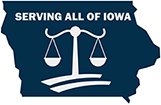Last Updated: 1/19/2023
According to the National Highway Traffic Safety Administration (NHTSA), every year more than 4,000 pedestrians are killed in traffic accidents and tens of thousands are injured across the United States. It is imperative that pedestrians learn about the pedestrian laws in their state to ensure they’re in compliance and prevent dangerous accidents.
The NHTSA reports that 75 percent of pedestrian accidents occur in urban areas, on clear or cloudy days, and at nighttime. Read about the pedestrian laws in Iowa before chasing an accident claim.
The Pedestrian Laws in Iowa
In Iowa, traffic laws specify that pedestrians must obey the rules of the road and the traffic control signals. They also dictate who has the right of way at intersections and elsewhere on the road. A pedestrian has the right of way at intersections where there are no traffic lights and when walking on the crosswalk, both marked and unmarked.
A motorist has to yield to pedestrians when entering or leaving:
- a driveway;
- parking lot; or
- an alley.
However, pedestrians should be extremely cautious when crossing and never assume that a vehicle will stop even if a law mandates it.
The above-mentioned law also entails that a pedestrian give right of way to motorists, which also includes cyclists, when crossing a road at any point other than an intersection, where there are no marked or unmarked crosswalks. A pedestrian has to also give the right of way to motorists and cyclists when crossing a roadway where a pedestrian tunnel or overhead crossing is available.
Further, a pedestrian must stay on the left side and thus face oncoming traffic when walking on or along a road or a highway where there is no sidewalk. This is also logical as well since if someone is driving badly or swerves, the pedestrian can attempt to move out of the way.
Iowa traffic laws also address hitchhiking. Pedestrians cannot stand on the roadway even for the purpose of soliciting vehicles to hitchhike. However, a walker can stand on any portion of a roadway that is usually not used by vehicles to solicit a ride from any motorist.
Law-Abiding Pedestrians Who End Up as Accident Victims
Like pedestrian laws, there are also specific laws for motorists in Iowa to ensure that the latter can be safe on the roads and to prevent causing harm to walkers and cyclists. However, in spite of all the laws, pedestrians often become involved in a motor accident through no fault of their own.
Pedestrians who are injured in road accidents because a motorist may have failed to abide by laws can file for damages and seek compensation for the physical and emotional trauma suffered.
For help pursuing compensation, a pedestrian who has been the victim of a road accident must not only prove the fault of the motorist but also must demonstrate the damages associated with the accident and resultant injuries.
Pedestrians can present:
- medical bills;
- evidence of lost wages; and
- various documentation, testimony or other evidence to establish other types of damages.
This may be a challenging task if the plaintiff does not obtain the guidance of a personal injury attorney who is familiar with these cases. An attorney can not only help collect evidence, but can assist victims in building a case that establishes a motorist’s negligence caused the accident.
Legal Help for Pedestrians in Iowa
If you or a loved one has suffered injuries as a result of a pedestrian accident, Walker, Billingsley & Bair can help. We provide legal assistance to pedestrians in Iowa who have been in a road accident caused by another’s negligence. Call us today to set up your free consultation: (641) 792-3595.


 According to the National Highway Traffic Safety Administration (NHTSA), every year more than 4,000 pedestrians are killed in
According to the National Highway Traffic Safety Administration (NHTSA), every year more than 4,000 pedestrians are killed in 